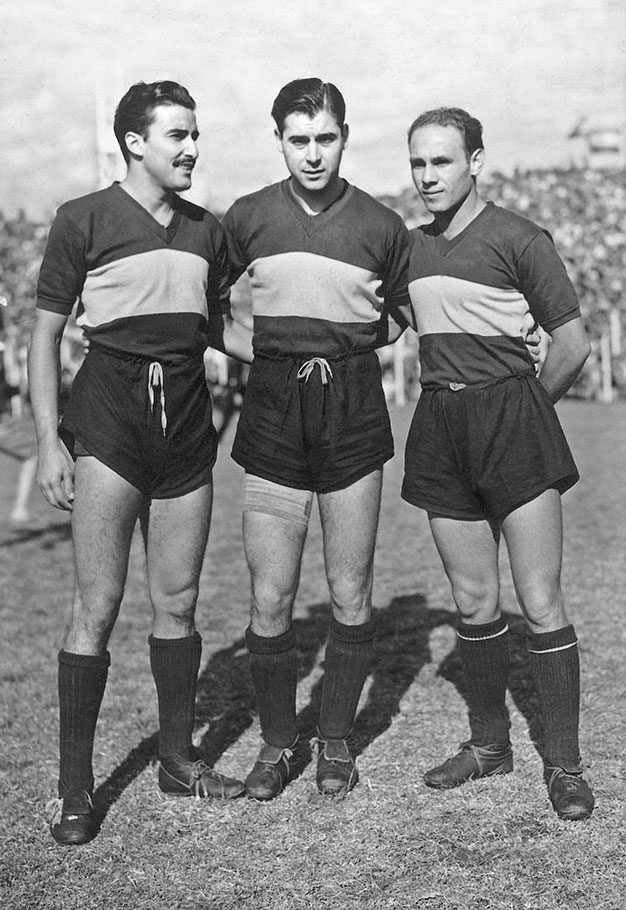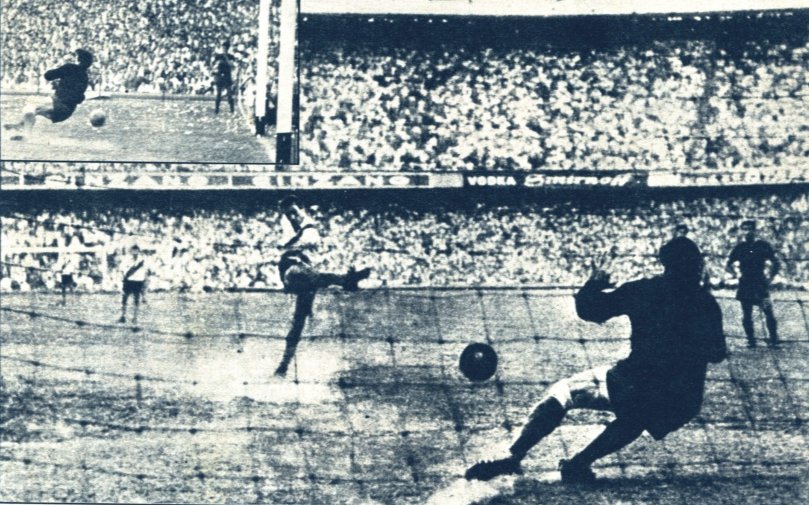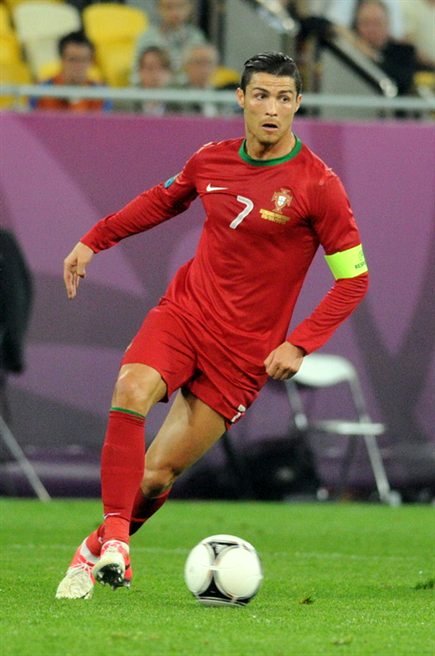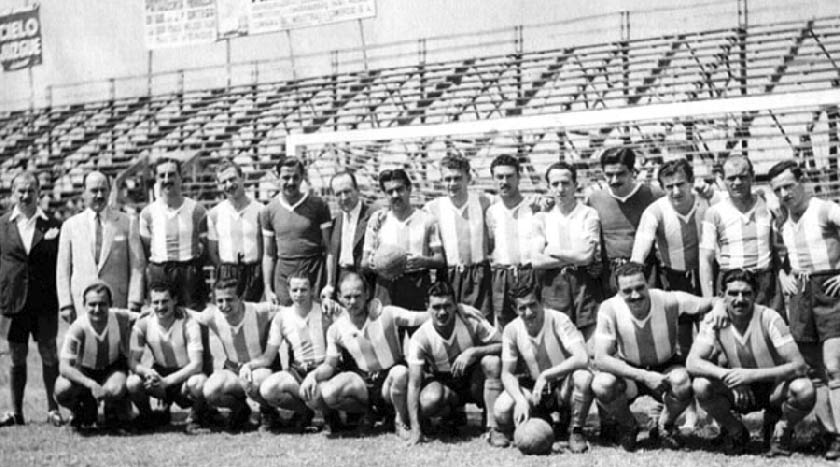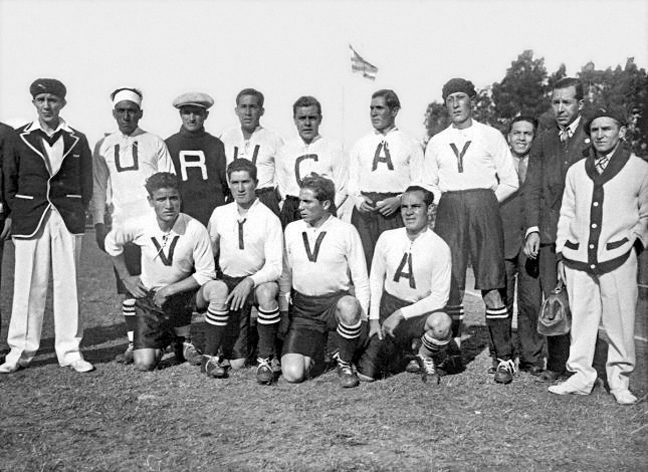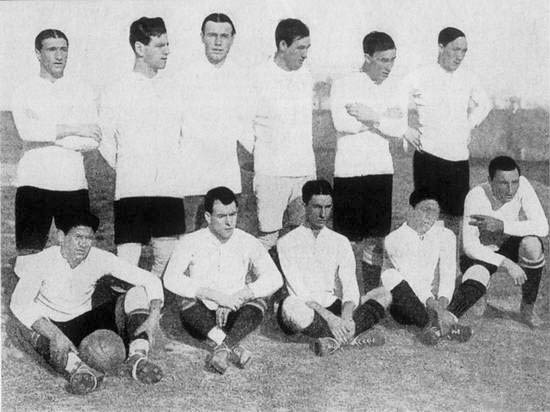|
Natalio Pescia
Natalio Agustín Pescia (January 1, 1922 – November 11, 1989) was an Argentine football midfielder, born in Dock Sud district of Avellaneda Partido. He played his entire club career for Boca Juniors in Argentina. Pescia played a total of 364 games for Boca in all competitions scoring 7 goals for the club. He also won 7 championships with the club, 3 domestic leagues, 2 national cups and 2 international cups. He was part of a historic midfield line, along with Carlos Sosa and Ernesto Lazzatti. Biography Pescia was selected by Boca Juniors at 12 years old, starting at the 7th. division. He debuted in the senior squad on August 30, 1942, when Boca was beat by Chacarita Juniors by 2–1. The next season, Pescia was part of one of the most remembered midfield lines in the history of the club, along with Carlos Sosa and Ernesto Lazzatti between 1943 and 1947 when Boca Juniors won the 1943 and 1944 domestic leagues, apart from one Copa Ibarguren, one Copa de Competencia Brit� ... [...More Info...] [...Related Items...] OR: [Wikipedia] [Google] [Baidu] |
Argentina
Argentina, officially the Argentine Republic, is a country in the southern half of South America. It covers an area of , making it the List of South American countries by area, second-largest country in South America after Brazil, the fourth-largest country in the Americas, and the List of countries and dependencies by area, eighth-largest country in the world. Argentina shares the bulk of the Southern Cone with Chile to the west, and is also bordered by Bolivia and Paraguay to the north, Brazil to the northeast, Uruguay and the South Atlantic Ocean to the east, and the Drake Passage to the south. Argentina is a Federation, federal state subdivided into twenty-three Provinces of Argentina, provinces, and one autonomous city, which is the federal capital and List of cities in Argentina by population, largest city of the nation, Buenos Aires. The provinces and the capital have their own constitutions, but exist under a Federalism, federal system. Argentina claims sovereignty ov ... [...More Info...] [...Related Items...] OR: [Wikipedia] [Google] [Baidu] |
Copa De Competencia Británica
The Copa de Competencia Británica George VI was an official Argentine football cup competition, played from 1944 to 1948. It was contested by teams participating in Primera División. The format was a single-elimination tournament and the first editions (1944 and 1945) allowed four semifinalist teams to play the "Copa de la República". The fourth edition was abandoned in the first stage and therefore the Argentine Football Association declared there was not a champion. The trophy was named after King George VI and donated by the ambassador of the United Kingdom The United Kingdom of Great Britain and Northern Ireland, commonly known as the United Kingdom (UK) or Britain, is a country in Northwestern Europe, off the coast of European mainland, the continental mainland. It comprises England, Scotlan ... in Argentina. Champions Finals Titles by team Topscorers Source: [...More Info...] [...Related Items...] OR: [Wikipedia] [Google] [Baidu] |
Alberto Armando
Alberto José Armando (February 4, 1910 – December 28, 1988) was an Argentine businessman and football manager. He was the president of club Boca Juniors from 1954 to 1955, and from 1960 to 1980. With Armando as president, Boca Juniors gained international recognition after winning its first Copa Libertadores (1977 and 1978) and the first Intercontinental Cup in 1977. The Boca Juniors stadium was renamed in his honour in December 2000 by then Club President Mauricio Macri. Life and career Armando was born in Santa Fe, Argentina, in 1910, and raised in nearby San Francisco, Córdoba. He married María Mercedes Crespo and became affiliated with the Boca Juniors football club in the 1940s, when he became known as ''El Puma''. Armando was elected president of Boca Juniors in early 1954, succeeding Daniel Gil. The team had struggled since its last First Division title, in 1944, though Gil's tenure could boast the enlargement and modernization of the La Bombonera stadium. Armando' ... [...More Info...] [...Related Items...] OR: [Wikipedia] [Google] [Baidu] |
Portugal National Football Team
The Portugal national football team () has represented Portugal in men's international Association football, football competitions since 1921. The national team is controlled by the Portuguese Football Federation (FPF), the governing body for football in Portugal. Portugal's home stadium is the Estádio Nacional in Oeiras, Portugal, Oeiras, located next to its primary Training ground (association football), training ground and the FPF headquarters (''Cidade do Futebol''), but the team generally plays its home matches in stadiums across the country. The head coach is Roberto Martínez, and the captain is Cristiano Ronaldo, who holds the team records for most caps and most goals. Portugal's first participation in a major tournament finals was at the 1966 FIFA World Cup, 1966 World Cup, which saw a team featuring Ballon d'Or winner Eusébio finish in third place. Portugal also made it to the semi-finals of the UEFA Euro 1984, losing to the hosts and eventual winners France nationa ... [...More Info...] [...Related Items...] OR: [Wikipedia] [Google] [Baidu] |
1947 South American Championship
The 1947 South American Championship was the 20th South American Championship for national teams, and was organized by CONMEBOL. It marked the first time Ecuador hosted the tournament, which hosted all the matches in Estadio George Capwell in Guayaquil. Argentina won the tournament to obtain their ninth South American title. Brazil withdrew from the tournament. Format Each team played the teams in a single round-robin tournament, earning two points for a win, one point for a draw, and zero points for a loss. The team with the most points at the end of the tournament will be crowned the champions. Squads For a complete list of participating squads see: '' 1947 South American Championship squads'' Venues Final round ---- ---- ---- ---- ---- ---- ---- ---- ---- ---- ---- ---- ---- ---- ---- ---- ---- ---- ---- ---- ---- ---- ---- ---- ---- ---- ---- Result Goal scorers 8 Goals * Nicolás Falero 6 Goals * Alfredo Di Stéfano * Norberto ... [...More Info...] [...Related Items...] OR: [Wikipedia] [Google] [Baidu] |
Bolivia National Football Team
The Bolivia national football team (), nicknamed ''La Verde'', has represented Bolivia in men's international Association football, football since 1926. Organized by the Bolivian Football Federation, Federación Boliviana de Fútbol (), it is one of the ten members of FIFA's South American Football Confederation (CONMEBOL). After playing in the 1930 FIFA World Cup, 1930 and 1950 FIFA World Cup, 1950 FIFA World Cup, World Cups, they have qualified just once, in 1994 FIFA World Cup, 1994, where they were eliminated in the group stage. Bolivia have never advanced past the first round of any World Cup, and have only scored one goal, in 1994. Despite their World Cup performances, Bolivia won the Copa América at home in 1963 South American Championship, 1963, and finished runners-up in 1997 Copa América, 1997, which they also hosted. At the 2015 Copa América in Chile, they advanced to the quarter-finals for the first time since 1997, after defeating Ecuador national football team, ... [...More Info...] [...Related Items...] OR: [Wikipedia] [Google] [Baidu] |
1946 South American Championship
The nineteenth edition of the South American Championship in football was held in Buenos Aires, Argentina from 12 January to 10 February. This tournament, an ''extra'' edition with no trophy handed to the winners, is considered official by CONMEBOL. The participating countries were Argentina, Brazil, Bolivia, Chile, Paraguay, and Uruguay. Colombia, Ecuador, and Peru withdrew from the tournament. Venues Squads Final round Each team played against each of the other teams. Two points were awarded for a win, one point for a draw and zero points for a defeat. ---- ---- ---- ---- ---- ---- ---- ---- ---- ---- ---- ---- ---- ---- Result Goal scorers 7 Goals * José M. Medina 5 goals * Ángel Labruna * Norberto Méndez * Zizinho 4 goals * Juan Villalba 3 goals * Heleno * Araya * Atilio Cremaschi 2 goals * Adolfo Pedernera * Juan C. Salvini * Miguel Peredo * Chico * Jair 1 goal * Vicente De la Mata * Félix Loustau * Rin ... [...More Info...] [...Related Items...] OR: [Wikipedia] [Google] [Baidu] |
Copa América
The CONMEBOL Copa América (; known until 1975 as the South American Football Championship), often simply called the Copa America, is the top men's quadrennial association football, football tournament contested among list of men's national association football teams, national teams from South America. It is the oldest still-running continental football competition. The competition determines the Continental football championships, champions of South America, minus Suriname national football team, Suriname, Guyana national football team, Guyana and French Guiana national football team, French Guiana. Since the 1990s, teams from North America and Asia have also been invited to compete. Eight of the ten CONMEBOL national teams have won the tournament at least once in its 48 stagings since the event's inauguration in 1916, with Ecuador national football team, Ecuador and Venezuela national football team, Venezuela the only teams yet to win. Argentina national football team, Argenti ... [...More Info...] [...Related Items...] OR: [Wikipedia] [Google] [Baidu] |
1945 South American Championship
The eighteenth edition of the South American Championship was held in Santiago, Chile, Santiago, Chile from 14 January to 28 February. This tournament was an ''extra'' edition, with no trophy handed to the winners, but considered official by CONMEBOL. The participating countries were Argentina national football team, Argentina, Bolivia national football team, Bolivia, Brazil national football team, Brazil, Chile national football team, Chile, Colombia national football team, Colombia (for the first time), Ecuador national football team, Ecuador, and Uruguay national football team, Uruguay. Paraguay national football team, Paraguay and Peru national football team, Peru withdrew from the tournament. Squads For a complete list of participating squads see: ''1945 South American Championship squads'' Venues Final round Each team played against each of the other teams. Two points were awarded for a win, one point for a draw and zero points for a defeat. ---- ---- ---- ---- ... [...More Info...] [...Related Items...] OR: [Wikipedia] [Google] [Baidu] |
Club Olimpia
Club Olimpia is a Paraguayan professional sports club based in the city of Asunción. It promotes the practice of various sports, with most importance given to the football, rugby and basketball sides, football being the most successful. Founded in 1902, the club's name stems from the idea of its principal founding member, William Paats, a Dutchman based in Paraguay, who is considered the father of Paraguayan football.Internationally, the club is referred to as Olimpia Asunción in order to distinguish it from other Latin American football clubs of the same name. Olimpia has won a record 47 Primera División titles to date, including a unique record run of winning the league six consecutive times. The only Paraguayan club to win a CONMEBOL title, Olimpia has won three Copa Libertadores — and has been runner-up four times — as well as two Recopa Sudamericanas, one Intercontinental Cup, one Copa Interamericana, and one Supercopa Sudamericana, a competition it won autom ... [...More Info...] [...Related Items...] OR: [Wikipedia] [Google] [Baidu] |
Paraguay
Paraguay, officially the Republic of Paraguay, is a landlocked country in South America. It is bordered by Argentina to the Argentina–Paraguay border, south and southwest, Brazil to the Brazil–Paraguay border, east and northeast, and Bolivia to the northwest. It has a population of around 6.1 million, nearly 2.3 million of whom live in the Capital city, capital and largest city of Asunción, and its surrounding metro area. Spanish conquistadores arrived in 1524, and in 1537 established the city of Asunción, the first capital of the Governorate of the Río de la Plata. During the 17th century, Paraguay was the center of Reductions, Jesuit missions, where the native Guaraní people were converted to Christianity and introduced to European culture. After the Suppression of the Society of Jesus, expulsion of the Jesuits from Spanish territories in 1767, Paraguay increasingly became a peripheral colony. Following Independence of Paraguay, independence from Spain ... [...More Info...] [...Related Items...] OR: [Wikipedia] [Google] [Baidu] |
